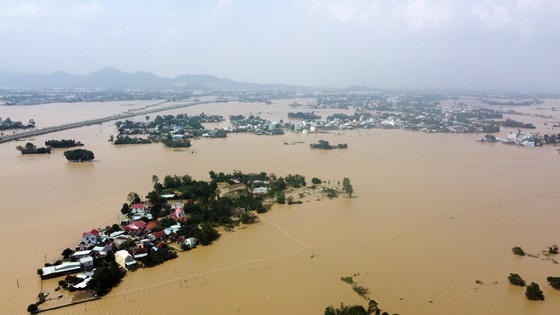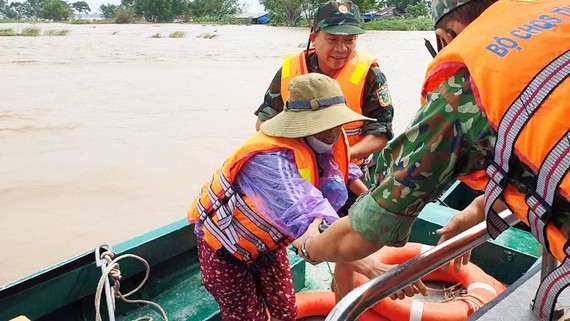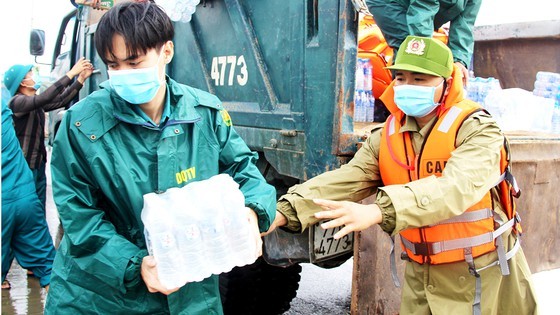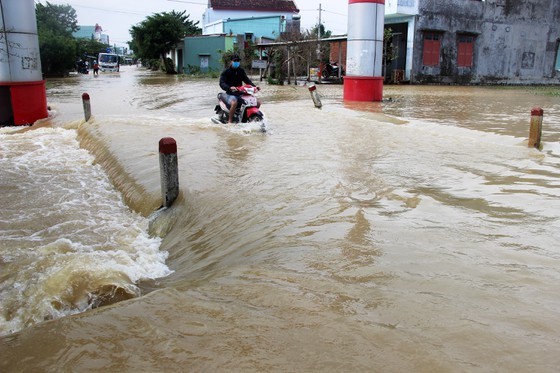 Flood seperates a village in Central Vietnam
Flood seperates a village in Central Vietnam
From the night of November 30 to the morning of December 1, it stopped raining in the Central Provinces of Binh Dinh and Phu Yen, people began to clean their houses, collect remaining property and search for missing people.
However, the water volume discharged from small hydroelectric plants and irrigation reservoirs is great; as a result, the Kon River in Binh Dinh Province and Ba River in Phu Yen Province swell to a high level, so many households have been still submerged.
On December 1, staff of competent agencies in Tuy Phuoc District in Binh Dinh Province canoed to Phuoc Thuan and Phuoc Nghia communes to supply drinking water, instant noodles, vegetables and clothes for the children.
Many benefactors in Quy Nhon City also cook hundreds of rice meals to provide for people in flood-prone Tuy Phuoc areas. Old woman Do Thi Xuan in Huynh Mai village in Phuoc Nghia Commune remembered that on the night of November 30, flood water submerged the house, she couldn’t do anything but ran to a neighbor's house in higher areas.
Subsequently, furniture, beds, blankets, clothes, books were submerged in floodwater and damaged.
Chairman of the People's Committee of Cat Hai commune Le Van Dieu said that the flood left thousands of homes beyond repair and trees fallen. Moreover, the flood led to the death of buffaloes, chickens, ducks, rice.
 Soldiers evacuate people to safer shelters
Soldiers evacuate people to safer shelters
 Many roads are eroded because of prolonged flooding
Many roads are eroded because of prolonged flooding
The local administration is helping residents to overcome the flood damage. In the immediate future, the local authority will give VND5 million to collapsed houses, said Mr. Dieu.
In Khanh Hoa Province, prolonged heavy rain and water discharged from hydroelectric power plants in the past few days caused flooding in communes Vinh Hiep, Vinh Trung, Vinh Phuong, Vinh Ngoc in Nha Trang City and other localities in Dien Khanh District.
Flood water overflowed into residential areas submerging houses, in some places, the water level rose more than 2m. The lives of 35,000 inhabitants have been affected and 800 hectares of paddy fields have been inundated. Because of prolonged flooding, many roads were eroded, cascading soil and rock closed roads causing traffic jams.
Due to the unforeseeable development of floods in the South Central region and the Central Highlands, on December 1, in Hanoi, Minister of Agriculture and Rural Development Le Minh Hoan, Deputy Head of the National Steering Committee for Natural Disaster Prevention and Control, chaired a meeting to deploy response solutions.
According to head of the Central Steering Committee on Natural Disaster Prevention and Control Tran Quang Hoai, the Central region has a complex system of inter-reservoir operations; therefore, when it rains heavily, water from the upper lake is discharged into the lower lake.
Minister of Agriculture and Rural Development Le Minh Hoan requested localities to strictly comply with the Prime Minister's instructions. Local administrations should promptly evacuate people from dangerous areas as well as ensure safety against the Covid-19 epidemic and food and necessities for people in concentrated evacuation shelters.
The Minister also asked the office of the National Steering Committee for Natural Disaster Prevention and Control to coordinate with the Ministry of Industry and Trade to review the operation of hydropower reservoirs to learn lessons from experience.
In Gia Lai and Phu Yen provinces, five hydropower plants An Khe, Kanak, Ba Ha River, Hinh River and Krong H'nang still continue to discharge floodwater to ensure the safety of the works. The Ba Ha River hydropower plant had to discharge approximately 4,280 cubic meters on December 1.
In Phu Yen, flood water gradually receded, leaving 12,450 houses flooded by 0.5-1m and 5,330 houses slightly flooded in Dong Hoa, Tay Hoa, Phu Hoa, Tuy An, and Dong Xuan. In Binh Dinh, 12,695 houses were flooded in cities Quy Nhon, Tuy Phuoc, Phu Cat and An Nhon.
 Young people carry water and food to residents
Young people carry water and food to residents
 A section of a submerged road
A section of a submerged road
























